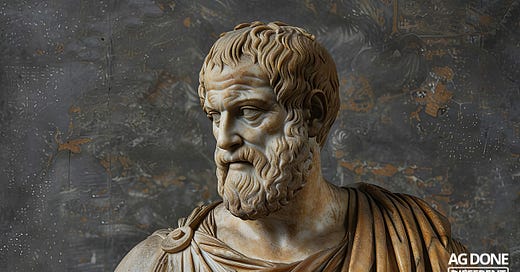Farming the Future: Aristotle’s Guide to Innovation in Agriculture
In order for a different future to occur, we must imagine what is possible, live in the future, and make a compelling argument for why the rest of the world should join us.
More than two thousand years ago, Aristotle made a profound distinction between causality and contingency—one that continues to shape how we think about the world today.
Causality refers to events that “cannot be other than they are.” Contingencies, on the other hand, “present us with alternative possibilities.”
The development of a plant is causal. Growth only occurs when a seed is planted, watered, and provided with the right nutrients and sunlight. When one of these factors is interfered with or inhibited, the plant fails to grow optimally. This has been true for centuries and will remain true for centuries to come.
In the causal part of the world, our job is to understand the causes of the effects we observe and optimize around them. For instance, we pull soil samples to understand the nutritional profile of our fields and take action accordingly.
The way I harvest my corn crop is, by contrast, a contingency. It isn’t governed by fixed natural laws but by choices I make, such as the equipment I use and the strategies I employ to maximize efficiency and quality. This approach has evolved dramatically over time. 150 years ago, I might have harvested my corn with a sickle. Today, I use a combine.
In this contingent part of the world, our job as innovators is to become the cause of the effect we want to see. We must imagine the possible futures and make a compelling argument for the one we believe is best.
In agriculture today, there are fundamentally two kinds of people:
Those who bet on the future looking very similar to the past and present.
Those who bet on a different future.
If you’re in the first group, why are you reading this blog? Go read the latest edition of CropLife.
If you’re in the second group, then the next question becomes: What future are you imagining, and how will you convince the rest of the world to join you?
In order for a different future to occur, we must imagine what is possible, live in the future, and make a compelling argument for why the rest of the world should join us.
This is where we run smack into the data dilemma.
When we’re imagining a new future and pitching the idea to customers and investors, the first question that tends to arise is some form of, “Will it work?”
And “Will it work?” is precisely why so much agtech ends up looking exactly the same. It’s why sales leaders build ROI calculators. It’s why founders tie themselves in knots entering innovation challenges and running nebulous proof-of-concept projects for buyers who have no intention of giving them money.
The data dilemma for those creating a new future is simple: all data is from the past. And that’s where most innovation dies—relying solely on backward-looking metrics to justify forward-thinking ideas.
Instead, we should start by asking: “What would have to be true for our innovation to work?”
How would our customers have to behave?
How would our investors have to behave?
How would regulators have to behave?
How would our employees have to behave?
We need to build a structure for interpreting the results we see.
The bad news about data for the next 12 months is that there isn’t any. The good news is that in 12 months we could have tremendous levels of data to either validate or disprove our hypotheses about the way the world is becoming.
What we have to do is document what we know and what we believe about the future so that we can compare it to the results we observe. You must have a hypothesis that says, “This is how I think the world will react to what I’m building,” so that you can reflect on what you saw relative to what you thought.
It isn’t about whether we like data or don’t like data. It’s about identifying the type of problem we’re solving and determining the kind of data we need to solve it.
Don’t use the data you have to make all of your decisions, identify the data you need to mine to make the best argument for the future you’re building.
Make something different. Make people care. Make fans, not followers.




